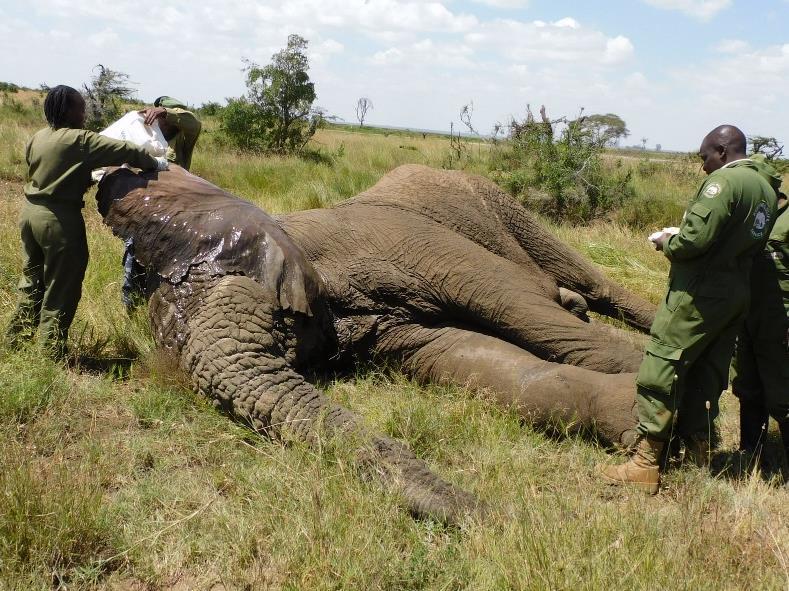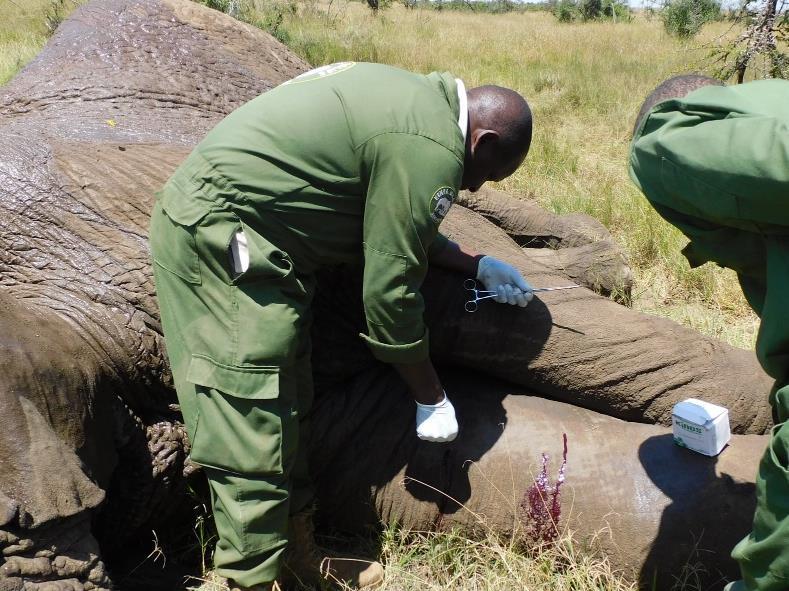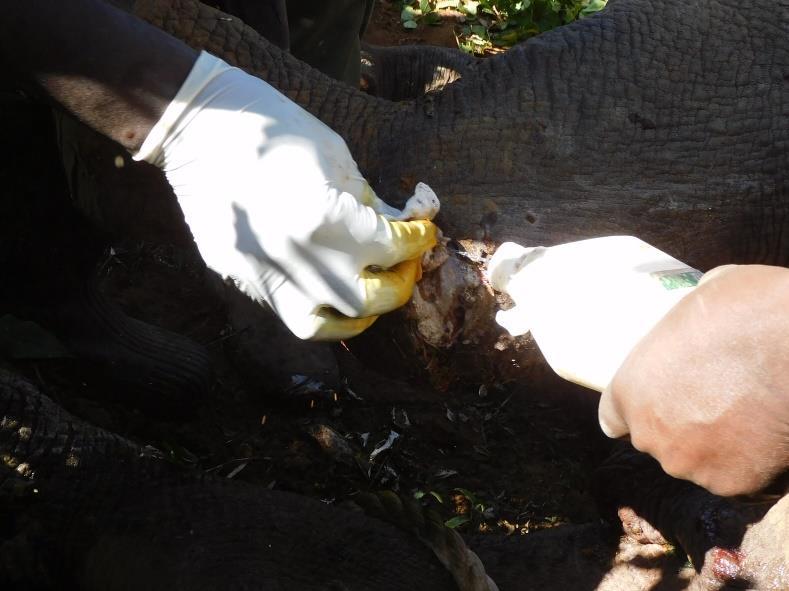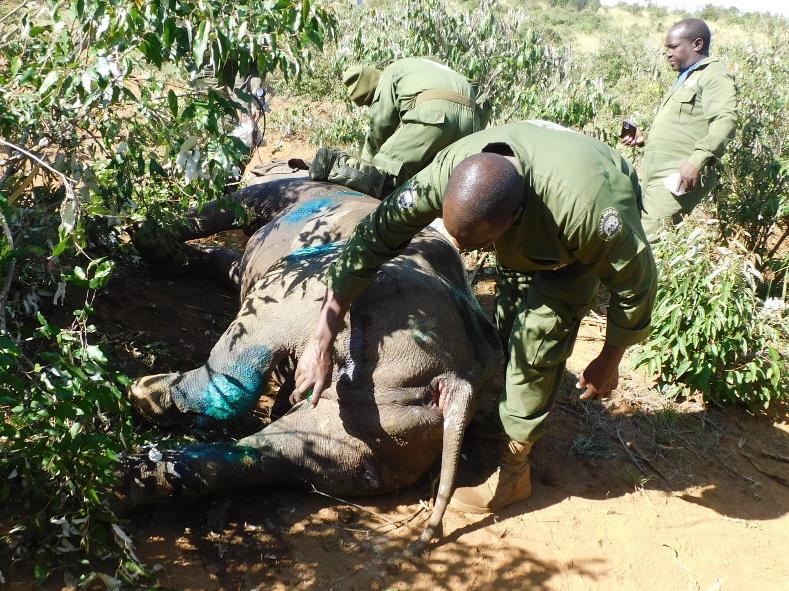
SWT/KWS MT KENYA MOBILE VETERINARY UNIT
JANUARY 2024




JANUARY 2024




The SWT/KWS Mt. Kenya Mobile Veterinary Unit attended to 8 Cases in January 2024. The veterinary unit performed a post-mortem on a black rhino carcass in Ol Jogi Conservancy and autopsies on 2 elephant bulls in Aberdare National Park. All these animals were found to have died from natural causes. The Mt. Kenya Veterinary Unit was also involved in the translocation of black rhinos from Nairobi National Park, Ol Pejeta Conservancy and Lewa Conservancy to Loisaba Conservancy. The team subsequently successfully treated 2 of these rhinos that were attacked by lions shortly after being released. Both animals were given a good prognosis for full recovery. Additionally, the team successfully collared a lioness in Mugie Ranch to mitigate human – wildlife conflict, and treated an elephant bull in Ngorare Ranch with a gunshot wound on the right forelimb.
The Mt. Kenya Mobile Wildlife Veterinary Unit thanks the Senior Assistant Director, Mountain Conservation Area and the Head of Veterinary Services, Kenya Wildlife Service for providing leadership and technical expertise. The veterinary team also appreciates The Sheldrick Wildlife Trust (SWT) for providing the financial and logistical support that enables the Unit to fulfil its mandate.


A sub- adult male black rhino, named Malo, was reported to have been attacked and killed by lions. The mother, named Kili, died in 2023 due to drought and old age.
The animal submitted for necropsy was a sub- adult male black rhino. The carcass was fresh, and the postmortem interval was estimated to be approximately 12 hours. Four lions were found feeding on the carcass. The body condition was good (scoring 3.5 on a scale of 5). The carcass was lying in left lateral recumbency. The carcass had bite marks on the neck and the perineal and thoracic areas had been eaten away. The ears and both lips had also been devoured The left hindlimb was missing and was found a few meters from the carcass.
The chest and perineal area were open and thoracic and abdominal contents had been eviscerated.
The cause of death was predation by lions.

The Mt. Kenya Mobile Veterinary Unit was tasked with collaring 3 lionesses in Mugie Conservancy to mitigate livestock depredation. The collars will enable rangers to monitor the movements of lions and alert Mugie management when the lions are close to cattle bomas.
Given the elusive nature of lions, a bait and callback system was set up in the evening and early morning. For the call back system, sounds of herbivores in distress were sounded at night. A carcass tied tightly onto a tree was used as bait to keep the lionesses in sight until darted. The lionesses were darted with 300mg Ketamine in combination with 4mg Medetomidine. A blindfold was then placed over the lion’s eyes to prevent stimulation by light. The nose-tail length, shoulder height and the paw and canine measurements were taken during the collar fitting exercise. Tissue samples were also collected for DNA analysis. A collar was fitted on the neck. Cloxacillin (Opticlox®) was infused into the dart wound and topical Oxytetracycline spray applied. 1,500 mg Amoxicillin and 4 mg Dexamethasone were administered intramuscularly. Fipronil (Frontline®) was then sprayed on the lionesses. After the effects of immobilization drugs were allowed to diminish through metabolism, reversal of anaesthesia was done with 10 mg Atipamezole intramuscularly. The lioness rose and walked away about 30 to 40 minutes after reversal although it was a little drowsy.

A lioness in Segera Conservancy was reported to have a broken lower canine that caused her a lot of discomfort and pain.
The lioness was easily located, she was found with another lioness and several cubs. The injured lioness was darted with 300mg Ketamine in combination with 4mg Medetomidine delivered using a Dan-Inject® CO2 rifle fired from a vehicle. She went into left lateral recumbency at 1510 hours, and a blindfold was placed over her eyes to prevent stimulation by light. Her body was also doused with water to manage hyperthermia. The lower canine was examined and found to be missing. It was deemed to have been dislodged by a strong zebra kick to the lioness’s mouth. Cloxacillin (Opticlox®) was infused into the dart wound and Oxytetracycline spray applied topically. 1,500 mg Amoxicillin was administered intramuscularly then the lioness was sprayed with Fipronil (Frontline®). After the effects of immobilization drugs were allowed to diminish through metabolism, reversal of anaesthesia was done with 10mg Atipamezole administered intramuscularly.
Prognosis
The lioness has a good prognosis.




In the afternoon hours on 16th January 2024, Aberdare National Park rangers reported that an elephant bull carcass had been found in the Salient Area. The Mt. Kenya Mobile Veterinary team travelled to the area to perform an autopsy on the carcass.
The carcass was found lying on the right flank and was in an advanced stage of decomposition. The head, neck, and the trunk had been devoured by scavengers and had decomposed. The tusks were intact. The carcass had no observable abnormal pathological signs pointing to an unnatural cause of death.
The cause of death could not be determined due to the advanced stage of autolysis. Unfortunately, there are no pictures for this case.
An adult male elephant was reported to have a massively swollen right forelimb.
Immobilisation, examination and treatment
The Veterinary team found the injured elephant bull with the help of ranch rangers. The elephant was darted from a vehicle with 18 mg Etorphine hydrochloride at 1239 hours. The elephant went down at 1300 hrs onto dog-sitting posture. A rope was used to position the animal onto right lateral recumbency. Upon examination, the animal was found to be in good body condition (score of 4 out of 5). A small penetrating wound was observed distal to the elbow joint. The wound had slight infection and was suspected to be a gunshot wound. It was flushed with dilute Hydrogen peroxide then it was rinsed and irrigated with Iodine. 45,000 mg Amoxicillin, 1,200mg Clindamycin and 5,000 mg Flunixin Meglumine were administered intramuscularly. Anaesthesia was reversed at 1333 hrs with 360 mg Naltrexone administered intravenously. The elephant bull was up after 3 minutes.
Prognosis
The elephant bull has a poor prognosis since the wound did not have an exit and no foreign object was recovered from the wound.




Aberdare National Park rangers reported that an elephant bull carcass had been found in Tharaa River area on 26th January 2024. The rangers had also noticed signs of an elephant fight in the area and blood splattered on the ground. The veterinary team travelled to the area by road to perform an autopsy on the carcass.
The carcass was found lying on the right flank at mid-advanced stage of decomposition. The head, neck, and the abdominal muscles had been eaten away by scavengers. The tusks were intact.
Several large puncture wounds resembling those made by tusks were observed on the chest area going deep into the thoracic cavity and severing major blood vessels causing haemorrhages and haemothorax. The blood splatter on the ground, the indicators of an elephant scuffle, and the large round puncture marks on the chest area are synonymous with elephant fight wounds.
The cause of death was a territorial fight with another elephant bull.


Ushindi, a 6.2-year-old female black rhino, was reported to have been attacked by lions shortly after being translocated from Ol Pejeta Conservancy to Loisaba Conservancy on 18th January 2024.
Immobilisation, examination and treatment
Ushindi was darted from a helicopter with 60mg Azaperone on the musculature of the right hip. The rhino went down on sternal recumbency, and a rope was used to further secure her. A blindfold was placed over her eyes to prevent stimulation by light. 10mg Butorphanol was administered intravenously, and oxygen insufflation started intra-nasally to improve cardio-respiratory function. Ushindi was in good body condition (score of 4 out of 5). Bite wounds were observed on the upper pelvic area, the vulva, medially just above the hock joint of the left hindlimb and her tail had been bitten off leaving a stump. She had also sustained abrasions on the distal metacarpus of both forelimbs, right thoracic wall and on the neck ventrally. The wounds were scrubbed with dilute Hydrogen peroxide, rinsed and irrigated with Iodine, and Oxytetracycline spray applied topically. 15,000mg Amoxicillin, 8,000mg Flunixin Meglumine, and 2,000mg Butaphosphan were administered intramuscularly. Anaesthesia was reversed with 200 mg Naltrexone.
Prognosis
Ushindi has a good prognosis

A 14.6-year-old black rhino was translocated from Ol Pejeta Conservancy to Loisaba Conservancy on 18th January 2024. While monitoring the animal post-release, wildlife trackers observed that the rhino had lion claw marks and lameness of the left hindlimb.
The rhino was darted from a helicopter and immobilized with 4mg Etorphine hydrochloride and 60mg Azaperone. The animal was blindfolded then 10mg Butorphanol and 20mg Doxapram were administered intravenously. Oxygen insufflation was also started intra-nasally to improve cardio-respiratory function. Upon examination, the rhino was found to be in good body condition (score of 4 out of 5). It had sustained deep bite wounds on the back (at the level of the thoracic vertebrae) and the hock of the left hindlimb had a deep penetrating wound. Abrasions were also sustained on the left thoracic wall and at the coccygeal region. The wounds were slightly infected.
The wounds were scrubbed with dilute Hydrogen peroxide then they were rinsed and irrigated with Iodine. After the cleaning, green clay was packed into the wounds and Oxytetracycline spray applied topically. Additionally, two tubes of Cloxacillin (Opticlox®) and 5 Oxytetracycline pessaries were packed into the wound at the hock joint. 15,000 mg Amoxicillin, 8,000 mg Flunixin Meglumine, and 2,000 mg Butaphosphan were administered intramuscularly. Anaesthesia was reversed with 100 mg Naltrexone.
The rhino has a good prognosis is good. However, it will take time for the wound at the hock joint to heal due to its location and depth.

